An account of the authors' 1997 visit to Burma's jade mines.
…and for to seeke out gemmes and some little stones, we strike pits deep within the ground. Thus wee plucke the very heart-strings out of her and all to weire on our finger, one gemme or pretious stone, to fulfill our pleasure and desire. How many hands are worne with digging and delving, that one joint of our finger might shine againe. Surely if there were any devils or infernal spirits beneath, ere this time verily these mines for to feed covetousness and rowt would have brought them up above ground. C. Plinius Secundus, The Historie of the World, 23–79 AD
Burma's Jade Mines • Heaven & Hell
In a remote corner of Upper Burma, thousands are busy, seeking, searching, clawing at a mountain, prying loose boulders from the compact brown soil. Jack hammers pound out a rat-a-tat beat, punctuated by the occasional cymbal crash of pick and shovel, while a choir of coolies stand behind with baskets to carry the debris out of this earthen tomb. As each boulder is turned over, it is quickly examined, then discarded. Over and over the process is repeated. It is a study in patience. Patience, patience – those who hurry lose, they make mistakes, they miss the prize, they don't go to heaven.
The construction of the Great Pyramids in Egypt was a study in patience; that in Upper Burma today is on no less a scale, but involves deconstruction, the dismantling of entire mountains, step by step, bit by bit, stone by stone, one pebble at a time. Like the builders of pyramids, all involved share a single-minded devotion to the task. Patience, patience – those who hurry lose, they miss something, they don't go to heaven. Those who hurry don't find jade.
 The imperial jade ring of a Hpakan laopan. Photo: R.W. Hughes
The imperial jade ring of a Hpakan laopan. Photo: R.W. Hughes
Building a bridge to heaven
In humanity's entire recorded history, there has never existed a more intimate relationship between a culture and a stone than that between the Chinese and jade. To the people of the Middle Kingdom, jade was not simply hardened earth – but, instead, solid magic – a tiny piece of heaven bequeathed by the gods to those of us destined to suffer here on earth. It was literally the link between heaven and earth, the bridge that allowed mortals to cross into immortality.
Up until the 13th century, "jade" was nephrite, a tough, white-to-green amphibole rock that was the ideal canvas for China's stone carving artists. Then, according to local lore, a Yunnan trader traveling through northern Burma picked up a boulder to balance the load on his mule. The stone proved to be jade, of a quality such that Chinese connoisseurs were sent into ecstasy. He had found jadeite, a brown-skinned mineral whose creamy insides combined the toughness of nephrite with the vivid green of emerald. The Chinese were smitten, head-over-heels in love with a stone found only at one locality in northern Burma.
When this more attractive form of jade appeared, the first order of business was to find the source. Yunnan's governor immediately dispatched an expedition to search for the mines, but it returned empty-handed, unable to locate the source. A second group was sent in the 14th century, but none returned, all perishing from malaria or at the hands of hostile Kachin hill tribes. Thus the source of the vivid green stone eluded even the Chinese. Every now and then small pieces of jadeite would appear in China, but their origin was to be an unsolved mystery for the next 500 years.
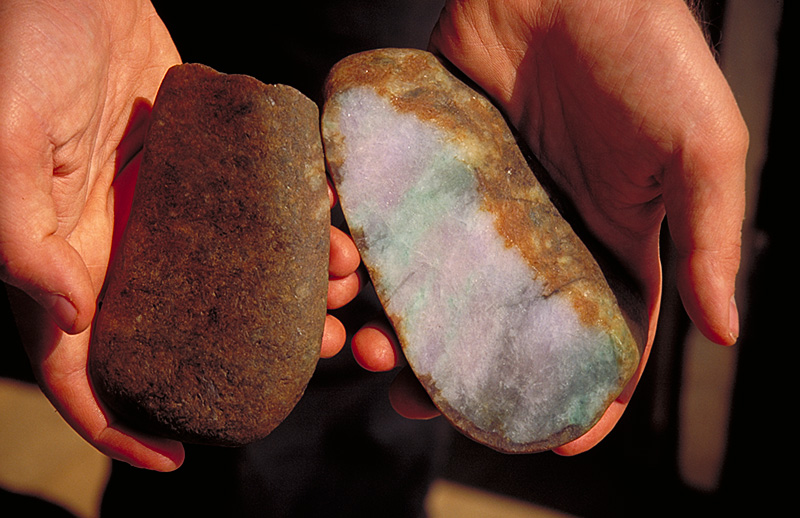 A handful of jade in one of Hpakan's jade markets. Photo: R.W. Hughes
A handful of jade in one of Hpakan's jade markets. Photo: R.W. Hughes
The breakthrough came in 1784, when the emperor, Qianlong (1736–96), of the Qing Dynasty (1644–1912) extended Chinese jurisdiction into northern Burma. Adventurous bands of Chinese soon discovered the source of the green stone, and from this date forward, considerable amounts of jadeite were transported from the mines to Beijing, where the world's finest jade carvers were located. Qianlong preferred the rich hues of this "new" jade (jadeite). By the 19th century, the top quality, with its combination of high transparency and rich fei-ts'ui ('kingfisher') green color, was designated "imperial jade."
By 1798, a well-established route for jadeite from Burma to China existed. Although it had to be altered several times to avoid bandits and political changes, the jade road through Yunnan operated throughout British colonial times, right up until World War II.
The Second World War brought an end to colonialism and, in its aftermath, the rise of a communist regime in China. Hard-core communists had no need for "bourgeois" vanities such as jade. Thus, for the first time in over five millennia, China turned its back on the Stone of Heaven. Thereafter, the trade of jade burrowed underground, largely shifting to Hong Kong, where carvers from Beijing and Shanghai soon followed.
But the communist regime was to be an aberration. Not long after Mao was safely in his grave, whispers about jade soon became an open craving – and again mules plodded on their tortuous journey from Burma's mines to the markets and workshops of China. Once again, the famous jade road was open.
Season of the witch
Burma's Kyaukseinmyo (literally 'Jade Land') is located about 350 km north of Mandalay. The administrative and trading center of the district is the small town of Hpakan, which lies amidst some of the planet's most inhospitable jungles. Sandwiched as it is between India's Nagaland (famous for headhunters) and China's Yunnan province, and with the Himalayas to the north, the country surrounding the mines has at times been described as "rugged."
 Map of Upper Burma, showing the authors' route to the jade mines at Hpakan. Illustration: R.W. Hughes
Map of Upper Burma, showing the authors' route to the jade mines at Hpakan. Illustration: R.W. Hughes
"Rugged" is a laugh. Rugged is for wimps, namby-pambies who run amuck with swagger sticks and flower-bedecked pith helmets. No, these jungles are not "rugged," they are a bad dream, a feverish Colonel Kurtz nightmare, an Apocalypse Now outtake best left on the cutting-room floor.
The mining district has but two seasons – mud and dust. Having experienced both, we must say it's a toss-up, like choosing between AIDS and the ebola virus. Pick your poison: the May-October monsoon turns everything in sight either green or brown, with all getting a thorough soaking. Roads morph into the wallowing mudholes of pigs, mosquitoes take flight carrying deadly strains of malaria and the most basic vehicular travel becomes a Homer-like odyssey where miles are measured in days. Leeches produce festering "Naga sores," and soon even the most gung-ho Rambos are reduced to blubbering heaps begging "God, gimme just one dry day, just one &%!#@#$ moistureless day!"
Dust never sleeps
But the dry season is no better. Whereas by January the roads again become motorable, the brown goo has now transformed into a hair-trigger combustible powder, requiring only the slightest breeze or movement to explode it airborne. Entire valleys are cloaked with a dust cloud that dissipates only with the onset of the rains, and every surface is caked with the stuff. Coal miners have their black-lung disease, Jade Land's dry-season residents a beige first cousin. When the monsoon has spent its force, once-raging rivers turn into excrement-filled trickles as weary travellers cry out with emphysemic bleats: "God, gimme me just a taste, just one bit of rain, just one &%!#@#$ wet day!"
No, in visiting the jade mines, the journey is not the reward. There is no thrill of victory in getting there and back, only the bittersweet knowledge that, upon returning home alive, one has avoided the agony of defeat.
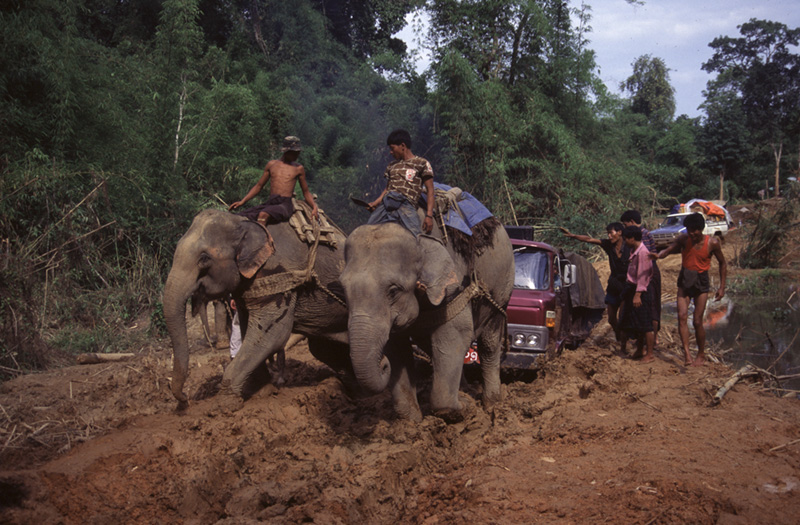 Just add water…
Just add water…
In the dry season, the Hopin-Hpakan road is relatively benign, but a bit of rain turns this into an impassible obstacle (see inset for the exact same spot in the rainy season). Inset: Andy Kaufman's paradise Elephants shriek and strain to pull a stranded truck from the mire of the Hopin-Hpakan road during the rainy season. Photo: Olivier Galibert
Nobody dreams of retirement in Hpakan. Only of making their fortune and getting out. Of the hundreds of people to which we spoke, we did not meet a single one who had spent more than a decade in the jade mines. The vast majority had been there less than a year. Not one of the government military officials we'd met on our first trip was there upon our return nine months later. A Burmese friend stationed there during the mid-1960s told us: "It was the worst year of my life."
So, we have a place that, while being mining heaven, is, by all accounts, hell on earth. Why do people come here? There is but one reason. Jade. This is the planet's sole source of imperial green jadeite. And it draws fortune-seekers like moths to a flame. A few make it big; most simply sear their wings in the heat of the fire and drop helplessly to the ground, buried beneath the mud, or covered by the dust that is Jade Land.
|
Monsoon madness: Reaching Jade Land in the wet season Caution? He missed the train in Mandalay. So for the monsoon trip between Hopin and Hpakan, we are saddled with a betel-nut fueled speed freak who is obviously being paid by Toyota to determine the amount of side torque a wheel can take before shearing from its axle.
As a sop to safety, our vehicle does have one of those fancy do-hickies on the dash, the kind of level that tells you when you are leaning, and when you are leaning too much. Useless, as we soon learn, since every time we get several degrees off the scale, we still remain upright. At Nyaungbin, we get our first glimpse of things to come. The small, L-shaped town is basically a staging point on the Hopin-Hpakan road, where vehicles gear up for the push into Jade Land. Our driver begins to strap on chains. Interesting. Next to us, another vehicle is removing them. What makes it notable is that it is a motorcycle. The mud-spattered rider tells us it took ten hours to come down from Hpakan and he only fell five times. Yes, this is looking interesting, indeed. Outside Nyaungbin, the road changes, twisting and turning like a long brown snake, while the forest creeps ever closer. Everywhere there is jungle, green, jungle, green, ubiquitous. This is obviously the road less traveled, but it's clear that when Robert Frost penned the bit about being better for the experience, he wasn't referring to this particular boulevard. Cresting a hill, a giant mud hole awaits, with a stuck truck right in our path. It is here that we see our first elephants, a common sight in the days ahead. All along the road, the giant beasts tug stranded vehicles from the mud, at a cost of 1,500 kyat ($12) per pull. But their services are not yet needed, as our driver is able to squeeze by. The bottom of the next hill reveals the mother of all bogs, a scene straight out of Dante's Mudferno. Here, a ten-wheeled truck lies like a beached whale, submerged up to its windows in the slimy goo and it looks as if only the onset of the dry season, eight months ahead, will liberate it from its brown tomb.
While elephants make ready to free the vehicle, three vendors sit on the sidelines selling refreshments. The implication is clear – "You're gonna be here a while." And we will be. Andy Kaufman would have loved it. First up is a single elephant, whose chain is strapped around the truck's bumper. When everything is secure, the signal is given. Thwack! The rider gives the elephant a sharp smack on the head with the back of his machete and all hell breaks loose. Trumpeting roars rock the forest as the great pachyderm strains to tug the truck free. Again and again it pulls, yanking, screaming, seething, while the truck's engine shrieks and moans. Black clouds of diesel cloak the participants as both engine and elephant whine in agony. All to no avail; the truck has sunk deeper still. Observing the proceedings, our driver asks if driving a truck is like this in America. Sadly, we reply in the negative. Driving a truck is like this only in this valley. And we expect, some 200 millennia later, an anthropologist will dig up the fossilized remains of just such a truck in one of these mud holes and declare it to be the missing link between savage and civilization. We just hope it's not our skeletons in it. A second elephant is now brought to the fore and chained to the stranded vehicle beside the first. Again, machetes flash and the jungle seethes with the sounds of the straining beasts. Slowly, as the truck rocks and whines, red tears trickle down the brow of one elephant – blood from the beating it is taking. But again, the truck refuses to budge. Refusing to admit defeat, our driver grasps the nettle directly. Gunning his engine, he makes a desperate dive into the hole, trying to pass alongside the truck. But it is not to be. Now two vehicles are hopelessly mired in the muck. As the sun slowly sets on this forlorn corner of the globe, its fading light carries with it our last hopes and, in its place, a grim realization descends – no Hpakan tonight, no miniskirted girls, no cold beer, no little Hong Kong. We now understand – we are gonna be here a while… |
Little Hong Kong: Town at the end of the universe
Considering the difficulty in getting there, what awaits the visitor in the valley of jade is all the more amazing. Amongst locals, Hpakan is known as "Little Hong Kong" because, like the former British Crown Colony, you can get anything you want. Whatever the apple of your sweetheart's desire, they sell it in Hpakan. French perfume, champagne and cognac, Swiss watches, Japanese electronics, it's all here. Just be prepared to pay the price, which is two to three times that found elsewhere in Burma. But exorbitant prices matter little at Hpakan, a topsy-turvy town in a topsy-turvy country, where today's taxi driver just might be tomorrow's tycoon.
 Sectioned jadeite boulder on offer in the jade market at Hpakan. Photo: R.W. Hughes
Sectioned jadeite boulder on offer in the jade market at Hpakan. Photo: R.W. Hughes
The wild, wild east
Driving into the towns and villages of Jade Land is like stepping into an oriental version of the old American mining town. Picture Cripple Creek, Virginia City, Fairbanks and every other wild-west town in its heyday and you have some idea of this place. Makapin, Hweka, Sate Mu, Hpakan, driving down their dusty boulevards, one almost expects to hear a honky-tonk piano or see a whisky bottle come flying through a saloon window. All have a temporary air – many dwellings being little more than makeshift shacks.
Along their bustling main streets one sees signs for Rolex watches and Hennessy cognac, testifying to the tremendous wealth simmering just beneath the dull exterior. Above the tin roofs are satellite dishes; beyond that lie the green hills, splattered everywhere with the brown of mining activity. In places, entire mountain tops are eaten away, as the human quest for the green stone oozes deeper and deeper into the surrounding jungle.
 The small village of Makapin lies on the southern edge of Burma's jade-producing area. Because it is a mining town with a strong Chinese influence, the main nightly entertainment is gambling. Mah-jongg might be expected since Makapin is so close to the Chinese border; the betting game certainly is popular. Unexpected was a huge roulette wheel marked with Chinese animal symbols and crowded with a group of anxious bettors. All these activities are lighted by candles or by small generator-powered fluorescent bulbs. Photo: R.W. Hughes
The small village of Makapin lies on the southern edge of Burma's jade-producing area. Because it is a mining town with a strong Chinese influence, the main nightly entertainment is gambling. Mah-jongg might be expected since Makapin is so close to the Chinese border; the betting game certainly is popular. Unexpected was a huge roulette wheel marked with Chinese animal symbols and crowded with a group of anxious bettors. All these activities are lighted by candles or by small generator-powered fluorescent bulbs. Photo: R.W. Hughes
And like the old mining towns of the American West, gambling and prostitution are the preferred leisure-time activities. Makapin's main street at night is a miniature Las Vegas strip, albeit with a wicked Macau twist. Crowds of gamblers line the muddy lane, shouting, pushing, hoping to coax their luck to the surface at games of chance, while painted ladies wink coquettishly at passersby from behind the curtained doorways of their "beauty parlors." Along with the dust, lust is in the air, so long as there is money in your pocket.
In the past few years, government liberalization of the mining and trading sectors has brought renewed vigor to the quest for jade. Long-abandoned mines are being reclaimed, and everywhere one looks signs of the current renaissance are on display. Jade Land, with its broad array of goods, wears the new prosperity openly, shamelessly.
The business of jade
From the time jade is won in the Jade Mines area until it leaves Mogaung in the rough for cutting there is much that is underhand, tortuous and complicated, and much unprofitable antagonism. In my opinion the whole business requires cleansing, straightening and the light of day thrown on it. Major F.L. Roberts, formerly Deputy Commissioner, Myitkyina
It is said that the jade business involves "luck." That's like calling a lottery ticket an investment in the future. The jade business is not about luck, it's about strapping your hopes and dreams straight onto the rim of the roulette wheel and letting the creator give it a long, hard spin.
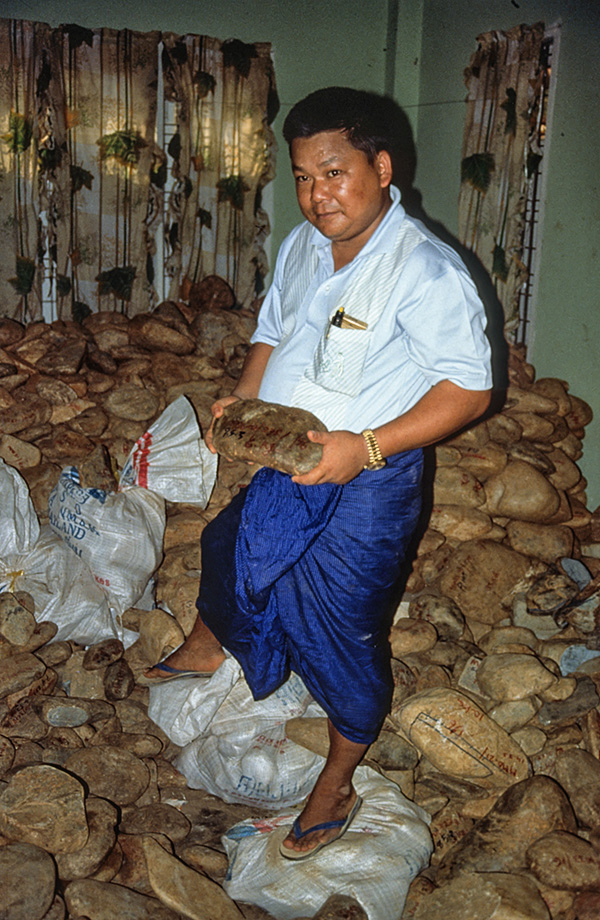 Figure 9 A room with a view U Tin Ngwe, who went from taxi driver to jade kingpin almost overnight, stands atop a small fortune of jade at his Hpakan home. Photo: Olivier Galibert
Figure 9 A room with a view U Tin Ngwe, who went from taxi driver to jade kingpin almost overnight, stands atop a small fortune of jade at his Hpakan home. Photo: Olivier Galibert
Just how much joss is involved is illustrated by the tale of U Tin Ngwe, one of Hpakan's many laopan (kingpins). He got his start behind the wheel of a large piece of rolling Japanese steel with a "taxi" sign on top. One day, a local jade trader he picked up offered him a spin of the green wheel, in the form of a grab bag of jade boulders. Picking up each piece, he studied them carefully. "Why not," he thought, as he forked over 3,000 kyat ($23 @ 130 kyat per dollar) for the heaviest boulder in the lot, "I feel lucky." He felt even luckier after selling the piece to another trader for 650,000 kyat ($5000). And that trader felt even luckier still after selling the exact same piece for over 3,000,000 kyat ($23,076). "Hmm," he thought to himself, "this jade stuff is interesting." It was so interesting that, today, U Tin Ngwe owns several jade mines and is one of the biggest traders in the valley. When the steel ball finally came to rest, it had stopped at his number.
Snake-eyes
Of course, every crapshoot has its losers, as well as winners. None who lived in Bangkok in the late-1970s can forget the story of… let's call him Sia Poh, who had invested a small fortune in one promising jade boulder. Many others were also eager to possess it; one went so far as to offer him several times his money. But Sia Poh refused to sell. He would cut it himself and, in the process, squeeze every possible drop of profit from the green stone. Alas, it was not to be. Cutting open the stone revealed only a cheap, ornamental-grade lump, worth perhaps $50. Lady luck had passed him by. In Sia Poh's case, the steel ball eventually stopped right between his eyes – exiting from the muzzle of the weapon with which he blew out his brains.
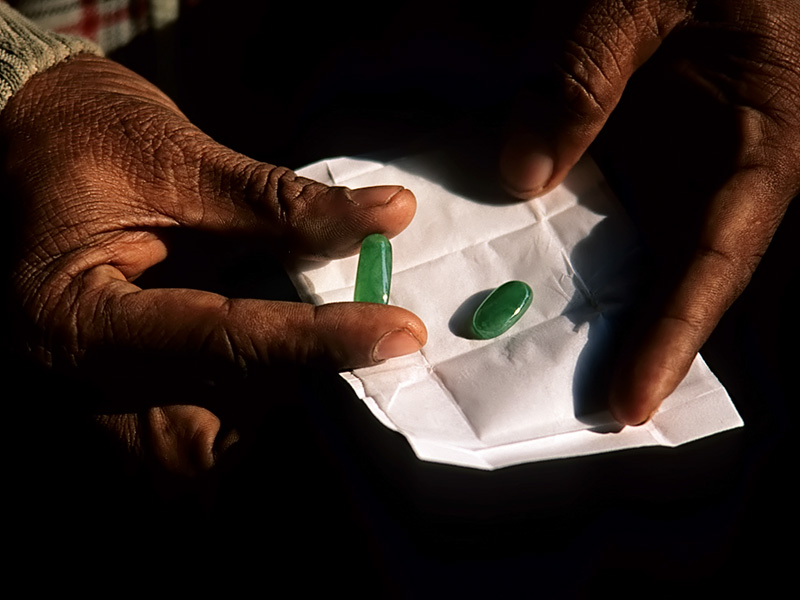 Jade on offer at Mandalay's open air jade market. Much of the material is treated or imitation. The stones shown here are white jade coated with green plastic. Photo: R.W. Hughes
Jade on offer at Mandalay's open air jade market. Much of the material is treated or imitation. The stones shown here are white jade coated with green plastic. Photo: R.W. Hughes
Judging quality: smoke and mirrors
Much of the mystery about the jade trade concerns just how a trader judges the quality of something encased in a rust-like oxidation skin so dense it hides all traces of color.
Traders will often wet the surface of a boulder to better see the color lurking within. They also utilize small metal plates and penlights. The plate is placed on the surface at a likely spot and a penlight shone through from the side furthest from the eye. This reveals color in the absence of glare from the light.
Traders and miners look for something they call pyat kyet (literally 'show points'), which are areas where the skin is thin enough to see through. And if there are no such show points? Heh, heh, heh. If we could answer that one we wouldn't be telling you now, would we?
 Sectioned jade boulder at Hpakan. The thick brown skin typically hides all traces of color inside. Only cutting reveals the true value. The pictured stone contains jade of both green and lavender colors. Photo: R.W. Hughes
Sectioned jade boulder at Hpakan. The thick brown skin typically hides all traces of color inside. Only cutting reveals the true value. The pictured stone contains jade of both green and lavender colors. Photo: R.W. Hughes
Desperately seeking green
In an effort to get right down to brass tacks, much jade is simply sawn open; this is the approach used at the government sponsored auctions in Yangon. But as owners don't particularly like their boulders defaced in such a manner, one has to pay to play that game. Parting a boulder down the middle has the added danger that one may cut right through a good area.
Experienced jade traders are said to be able to predict, by studying the outside of the boulder, what the inner color will be, but anyone who has ever seen boulders sawn open can prove the lie in that old wives' tale. Even for experts, much guesswork is still involved.
Before sawing, the surface is carefully examined to select the best place. There is no specific formula for cutting – it all depends on individual judgement and the rough's features. And let's not forget luck. In buying, say, a five-piece lot, sometimes all are good, and sometimes all are bad. As the great 11th-century gemologist, al-Biruni, put it: "God grants honor to some and disgrace to others."
Opium
According to one source, mining concessions in the Hpakan area are granted according to the projected value of the jade in the ground. Of course, the best spots cost lots of money, which the (mostly) Chinese mine owners pay to the central government. According to this source, only those with mighty deep pockets get involved, which in these hills usually means opium merchants.
 A miner takes a break to have a cigarette at Hpakangyi. Such Chinese bamboo water pipes (bongs) are also used for smoking opium, to which many miners are addicted. Photos: R.W. Hughes
A miner takes a break to have a cigarette at Hpakangyi. Such Chinese bamboo water pipes (bongs) are also used for smoking opium, to which many miners are addicted. Photos: R.W. Hughes
This source, who is quite close to one of Burma's top jade traders, told us that the jade business is often simply a sideline. Those in the drug business don't mind putting up a billion kyat (about $7.7 million) and only getting half back, because that half is now "clean" money. They can also afford to stockpile jade, giving buyers the impression that fine stones are more rare than is actually the case.
Those in the drug business also have a ready means to control the miners, many of whom are opium or heroin addicts. Diggers believe the drug will help prevent malaria and other diseases, but it's more likely the opium dreams just block out the nightmare that burrowing for jade entails. In any event, once addicted, the bosses can then easily control their workers, by regulating the supply of the drug.
The cocktail of opium and jade is a highly inflammable one and mafia-type gangland violence occasionally erupts. A few weeks before our first visit, a major miner (and also, reputedly, a drug dealer) was murdered in Myitkyina. The official version of the killing was that it was the work of a "mad man." Yeah right, him and JFK. One week prior to our second visit, a director of the Burmese military's "corporate" arm was gunned down on the doorstep of Hpakan's government guest house.
While the peace agreement was being negotiated in the early 1990s, soldiers from the Kachin Independence Army (KIA) were legally allowed into Hpakan for the first time. They didn't like what they saw. Heroin was being sold on the street, almost like Coca Cola, and junkies were shooting up right under the bridges in the middle of town. But the KIA solved that problem. Rounding up both heroin addicts and dealers, they took them down to the river, put a few bullets into them and dumped the bodies into the Uru chaung (river). Heroin is no longer sold openly in Hpakan. For those who are interested, the KIA made a videotape of the event. It is something to be viewed only on an empty stomach.
Be all you can be
For Burma's military, the jade mines represent a big fat pot of green gold at the end of the rainbow. And a stint at the mines is the payoff for a job well done. The rewards for being stationed there are many, for, in a district where coin flows like water, those positioned directly at the well get to drink to their hearts' content. During our time in the jade mines district, we came in contact with countless military officers but did not meet a single one who had spent more than six months in the area. You see, when it comes to jade, others must also get their chance to quench their thirst.
 Our military escort radios headquarters from Namlam, deep in Burma's Kachin State. Photo: R.W. Hughes
Our military escort radios headquarters from Namlam, deep in Burma's Kachin State. Photo: R.W. Hughes
Taxing questions
In all good businesses, it is inevitable that the government should want a piece of the action and so it is with the green stone. Many boulders have writing on them. This is a registration number, along with the weight, signifying that tax has been paid. Tax is paid in Hpakan, after evaluation by a government-appointed committee. The levy is 10% of the appraised value, but since many who sit on the committee are traders themselves, valuations tend to be "generous" to the seller.
Without paying tax, it is theoretically illegal to cut a boulder. But it does not take too great a leap of faith to see people simply cutting boulders without paying tax. In any event, today, almost all the boulders are said to be "legal," meaning that tax has been paid. And there are still some people who do write letters to Santa.
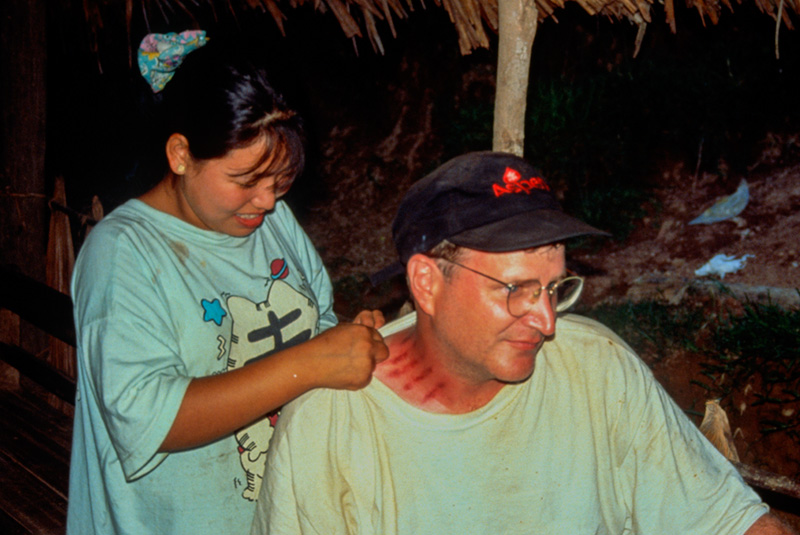 Bug spray
Bug spray
Malaria is a major concern for anyone living or traveling in the jade-mines area. In this land of animism, the preferred local solution is embossing the skin by pinching it with a coin. Here Richard Hughes has the treatment applied. The efficacy of this bug protection was made crystal clear in Mogaung, where Hughes and French gem dealer, Olivier Galibert slept side-by-side in the same bed. Come morning, Galibert's body was covered with bedbug bites, while Hughes was untouched. Photo: Mark Smith
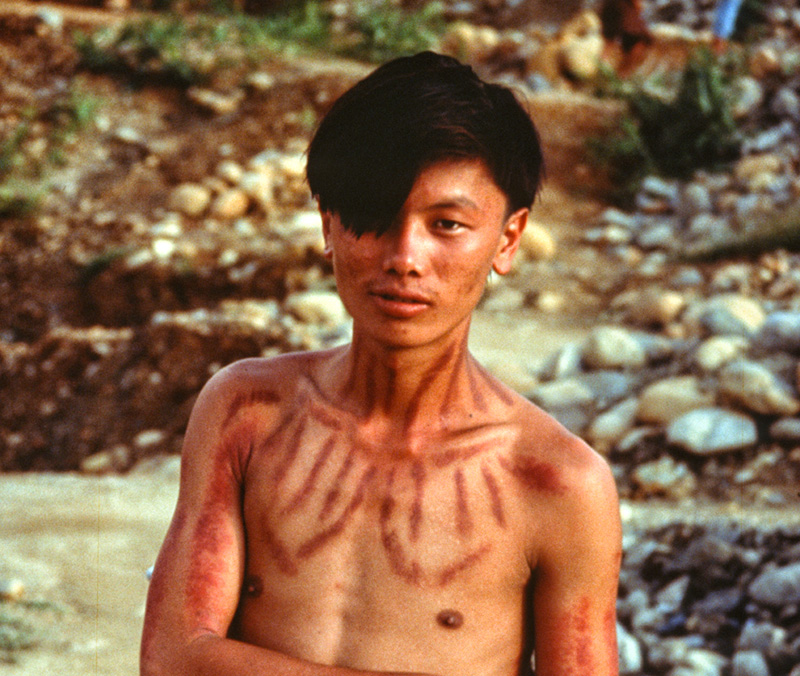 The Maw-sisa miner above is prepared for any kind of flying pest. Photo: R.W. Hughes
The Maw-sisa miner above is prepared for any kind of flying pest. Photo: R.W. Hughes
A mining we will go
Maw-sisa, just outside of Lonkin, is, in many respects, the quintessential mine, with jade recovered from alluvial deposits in the Uru river conglomerate. This formation is as much as 1000-feet deep in places, and present mining has just scratched the surface. Thus jadeite hoarders should take note – from what we could see, there is a good millennia or three's worth of material remaining to be extracted.
Each mining claim is just 15-feet wide; to keep from encroaching into the neighbor's area, a rope or thin wall of earth and boulders is left as a partition. When seen from above, the result is spectacular – several square miles of stair-step like benches, resembling nothing so much as a massive archeological dig. But diggers here do not search for mere bones or shards of pottery. Instead, they seek the Chinese holy grail, small pieces of heaven.
Dig it
At Maw-sisa, diggers were mining a black layer, locally termed ah may jaw. While jade is said to be richest in this layer, it can occur anywhere in the conglomerate.
The first step in mining is removal of the overburden, taung moo kyen (literally 'head cap removal'). Since the overburden is also conglomerate, it may also contain jade, so the workers must search this, too. We saw people working about 50 feet into the conglomerate, which they have stripped away with primitive tools.
Miners were asked how often they find jade. They said it depends on – guess what – luck. While some days they might find up to 25 pieces, other times they may go for days without finding anything. In terms of size, some boulders are 200–300 kg, some even as big as a house, but most are less than 1 kg.
 Jade is not only mined in alluvial deposits, but also from primary quarries, as shown here at Taw Maw. Like other alluvial-sourced gems, river jade is considered the most valuable, as the weathering process removes flawed areas. Photo: R.W. Hughes
Jade is not only mined in alluvial deposits, but also from primary quarries, as shown here at Taw Maw. Like other alluvial-sourced gems, river jade is considered the most valuable, as the weathering process removes flawed areas. Photo: R.W. Hughes
Greenhorns in Greenland
Upon reaching the mines, the first question any self-respecting person asks is: "By Jove and George, how in the heck do they do it?" Meaning, how do miners separate the quite occasional jade boulder from the thousands of others they also dig up that look so completely similar? If you or I had found it, we would simply have chucked a potential fortune straight into the neighbor's back yard.
Our investigations did put the question to rest, somewhat. Repeated questioning of various and sundry jade traders, cutters and miners yielded the following pearls of wisdom: jade boulders ring like a bell when struck with a pick. They feel heavier than ordinary rocks, have a fibrous texture and lack mica-like reflections. Jade also feels slightly sticky when wet. But most importantly, the miners look for "show points," areas where the green color shows through the skin.
At one spot, we saw miners carefully washing a blackish boulder, apparently to see if it was jade. When approached, they quickly tossed it aside, but then went back to it after we left. From a distance we watched. Brows furrowed as they scraped at it, only to throw it away in the end. Apparently even the miners themselves sometimes have difficulty identifying the look of heaven.
Dike mining
It is said that to find a dike is to become an instant millionaire. For while ordinary miners flail away in the common soil, they only rarely turn up a boulder of jade. The dike is the mother lode itself, a bridge straight to heaven.
In the jade mines district, several primary outcrops of jadeite have been located, the most famous of which is at Tawmaw. Formerly, miners employed fire and water to break away pieces of the jade. Today, peace has another dividend – dynamite – a godsend when dealing with a rock so tough that a day's worth of drilling might only penetrate 12 inches (30 cm).
Slowly down the river
For over 200 years, man has scoured the banks of the Uru river in search of jade. The keepers are quickly put away, with the others discarded, giving the area the look of a large ant hill. Centuries of labor has piled the banks high.
Jade is not the only treasure the river yields. Much gold mining is also in evidence, with the miners utilizing small portable sluices featuring ingenious bamboo riffles.
During seasons when the river is high, particularly at Mamon and Maw-sisa, men dive for jade. They breathe via crude air pumps, something akin to a triple bicycle hand pump. While a man on land furiously works the pump, the diver hops into the water and searches for jade with the plastic hose between his teeth, all the while praying those up top don't forget who's down there.The color of luck
Of all the mines in Jade Land, none is more impressive than that at Hpakangyi. Here, on the outskirts of Hpakan, lies the most important source of the green stone. As one crosses the rise separating Hpakan from Hpakangyi, all becomes clear. More than 10,000 workers coat an excavation several hundred feet deep, digging, carrying, shifting, loading, delving their way to heaven. For it is here that the green stone is found in its finest quality.

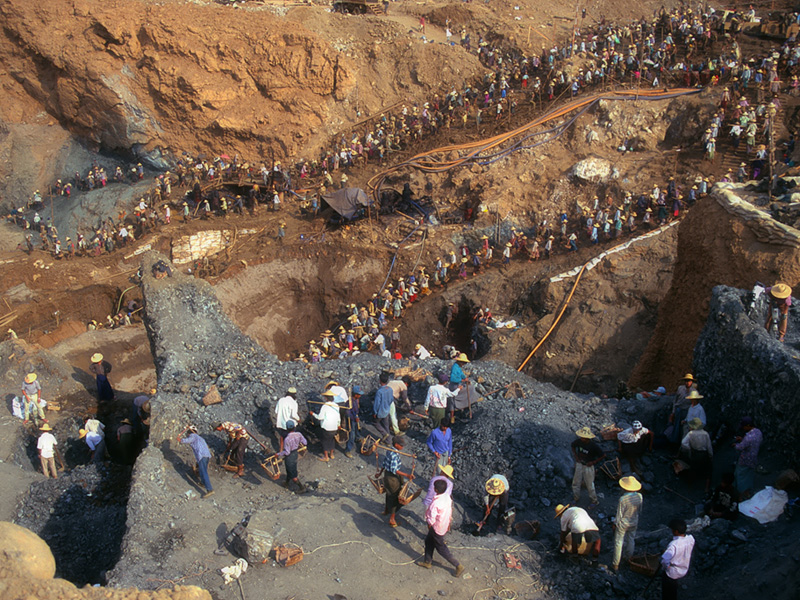

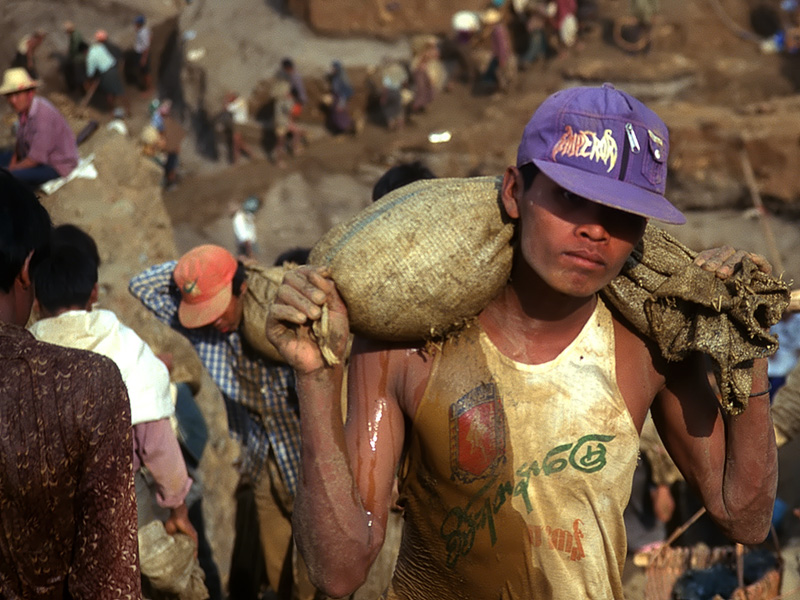 Building the pyramids
Building the pyramids
Over 10,000 miners snake up the hillside at Hpakangyi. Photos: R.W. Hughes
Patience, patience. So the Chinese bosses exhort their workers. For the laopans, patience is a virtue. But the coolies, who are paid only by how much earth they carry, have no time for patience. For the laborers, the goal is mere wealth. They care little for jade itself, seeing the green stone only as a road to gold – an escape from the poverty endemic to most of Burma. As one miner declared in broken English: "I am fortune seeker!" He made no mention of seeking jade. Patience? For the coolies, too much patience only prolongs their stay in hell.
 Sectioned jade boulder at Hpakan. The think brown skin typically hides all traces of color inside. Only cutting reveals the true value. Photo: R.W. Hughes
Sectioned jade boulder at Hpakan. The think brown skin typically hides all traces of color inside. Only cutting reveals the true value. Photo: R.W. Hughes
 Gambling fever
Gambling fever
At nightfall, many of the towns of Jade Land morph into miniature Las Vegases. Here an entire family watches a roulette wheel anxiously at Makapin. Note the small child asleep. Photo: R.W. Hughes
Leaving Las Vegas
Waste is piled into waiting trucks. As the trucks leave Hpakangyi, they need travel but a short distance to disgorge their loads. Crossing the bridge, they empty their waste directly beside the Uru river, right in the midst of Hpakan, center of the jade universe.
Patience, patience – those who hurry lose, they miss something, they don't find heaven. But at the river there are no Chinese bosses, no onlookers, no audience, only the search and the searchers. While trucks dump their loads, jade pickers scramble over the river bank looking for jade. Here there is no price per load, nobody to pay. Only the search in its purest form.
The diggers examine the boulders, give each a sharp rap with a hammer, then discard the unworthy. Patience, patience, clank, clunk, hammer against stone, patience, patience, hurry, hurry, discard, discard, and so it goes, hundreds of times. This is the Jade Land symphony, the imperial green of fei-ts'ui – the kingfisher.
In a corner of the dump, the drama climaxes. There it is – a trace of color – jade, stone of green, stone of wealth. This is luck, joss, fortune, the very essence of the jade business, something wrapped so tightly round the Stone of Heaven and its dancing partners that even the diamond-laced saw blade used to part the boulders cannot separate them.
The stone is quickly taken by motorcycle to an anonymous concrete house on the outskirts of Hpakan – no time to spare, hurry, hurry. Up a flight of stairs, where a laopan sits, waiting. Patience, patience – he knows those who hurry lose, they miss the prize, they don't find heaven.
After a brief examination, a bid is offered, refused, then accepted. As a wad of mud-stained bills changes hands, the laopan smiles to himself, content with the thought that he, the patient one, is now one step closer to heaven. As for the digger, he also smiles. For he, the one in a hurry, is now one step further from hell.

About the authors
Richard W. Hughes is one of the world’s foremost experts on ruby and sapphire. The author of several books and over 170 articles, his writings and photographs have appeared in a diverse range of publications, and he has received numerous industry awards. Co-winner of the 2004 Edward J. Gübelin Most Valuable Article Award from Gems & Gemology magazine, the following year he was awarded a Richard T. Liddicoat Journalism Award from the American Gem Society. In 2010, he received the Antonio C. Bonanno Award for Excellence in Gemology from the Accredited Gemologists Association. The Association Française de Gemmologie (AFG) in 2013 named Richard as one of the fifty most important figures that have shaped the history of gems since antiquity. In 2016, Richard was awarded a visiting professorship at Shanghai's Tongji University. 2017 saw the publication of Richard's Ruby & Sapphire: A Gemologist's Guide, arguably the most complete book ever published on a single gem species and the culmination of nearly four decades of work in gemology.
Fred Ward (1935–2016) was a remarkable professional photographer. Today he is remembered for his series of articles on gemstones in National Geographic magazine, and a series of small books based on the same, but his work spanned several decades. Highlights included his photos of JFK, the Beatles, and Fidel Castro.
Author's afterword
Written April 1997. This article was published in Asia Diamonds (Vol. 1, No. 2, September-October, pp. 42–53).



